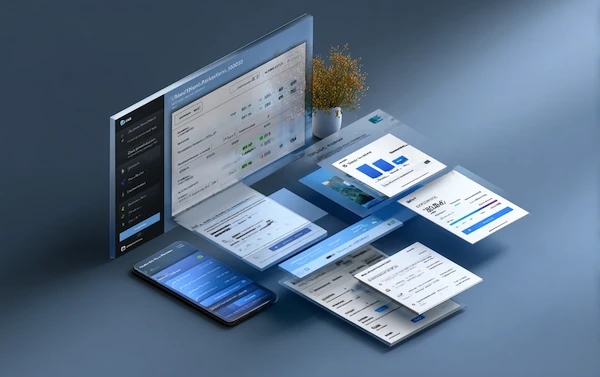Volume Incentive Rebate: Types, Examples & Benefits

A volume incentive rebate is just one of the various types of rebates that can promote increased sales and customer loyalty. When it comes to a customer rebate agreement, there’s a lot that has to take place behind the scenes in terms of accounting to fulfill the promises.
We’re going to look at what a rebates accounting entry looks like and see how finance automation software with rebate management can streamline the process.
Coming Up
What are Volume Rebate Programs?
What is the Difference Between Reward Incentive and Rebate Incentive?
What are Types of Rebate Incentives?
What are Examples of Rebate Incentives?
How do Volume Incentive Rebates Increase Sales?
What are the Benefits of Volume Incentive Rebates?
What are Best Practices for Managing Volume Incentive Rebates?
What is a Rebate?
A rebate is an incentive provided by a manufacturer, supplier, or retailer that gives money back to a purchaser after they make a purchase of a specific good or service.
Rebates act similarly to discounts in that they drive sales; however, a discount is provided to lower the price at the point of sale. A rebate doesn’t lower the price at the point of sale, it instead provides money back after the transaction has gone through.
In many instances, the buyer has to mail-in a rebate request, which then moves through a workflow to be matched against the rebate terms and approved before payout.
What are Rebate Incentives?
Rebate incentives are designed to prompt the sale of specific products or services. When a manufacturer or supplier provides a rebate incentive, it can promote increased trade with a specific partner, as customers have a reason to continue trading with the rebate partner over the competition.
Additionally, with a volume incentive rebate, the customer receives a higher rebate rate with greater volume.
What are Volume Rebate Programs?
Speaking of a volume incentive rebate, let’s drill down deeper into what it entails.
When a certain volume-based turnover is reached, the rebate is earned. This is a great incentive program for any company that is trying to push the sale of a certain product or to drive loyalty with one trade partner over another.
To exemplify, here’s one of the volume incentive examples to clarify how it works:
A volume rebate agreement is set up such that the buyer receives $1 per unit once the target of 5,000 units is met. So, if you purchase 6,000 units, then you earn $1 per unit (x$6,000), or $6,000 worth of rebates.
What is the Difference Between Reward Incentive and Rebate Incentive?
Reward and rebate incentives are both ways to increase sales. However, they are different in how and when they are granted.
A rebate incentive takes place after the purchase has already been made. The customer can either receive a discount or cash back.
A reward incentive can be discounts, coupons, or loyalty points that can then be applied to a purchase - either at the time of sale or a future purchase.
What are Types of Rebate Incentives?
Rebate incentives aren’t one-size-fits-all. There are different types of rebates that you can enact depending on what you wish to accomplish. Here are some of the most commonly use rebate incentives:
1. Volume Rebates
We’re focused on volume incentive rebates specifically because they are so popular. Most distributors use a volume incentive rebate because they are effective!
The two types of volume incentive rebates are:
- Retrospective: The highest rebate offer (based on surpassing a certain threshold) is applied to the entire purchase. Say you can earn $1 off for up to 500 units and then $2 off for more than 500 units, and you purchase 550 units. In a retrospective set up, you’d earn $2 off on every unit.
- Non-retrospective: In a non-retrospective rebate incentive, you earn each rebate rate according to the units in that tier. So, in the example above, you’d get $1 off for 500 units, and then $2 off for the remainder.
2. Product Mix Incentives
When you have low-margin products and high-margin products, it can work in your favor to set up a product mix rebate offer. This means that you can bundle these products together such that the low-margin and popular SKUs are placed together with high-margin, less popular items.
3. Growth-based Rebate
For partners that increase their annual growth in volume of sales or revenue, there are incremental rebate benefits provided for reaching higher thresholds.
4. Flat Rebates
Flat rebates are a set rebate that doesn’t scale according to volume or value. It is a set rate no matter how much is being purchased.
Regardless of the type of rebate incentive offered, there’s a lot of planning that has to be done to make it work. From contract terms to tracking transactions, reconciliation accounts, and then paying buyers on time, it’s an added strain for accounting teams to manage rebate incentive programs.
Automation software eases the burden by streamlining rebate tracking, calculations, and payouts so that customers, accounting teams, stakeholders, managers, and sales teams can all be aligned.
What are Examples of Rebate Incentives?
With real workable numbers, let’s look at what rebate incentives look like in practice:
- Fixed Rebate: A rebate agreement states that if a customer buys 100 units of a product, they’ll receive a 10% rebate. Each unit costs $5, making the total $500. In this case, the customer would receive a $50 rebate.
- Growth-based Rebate: To receive a rebate of $500, a customer must purchase 10% more this year than last year. So, if they purchased 100 units last year, they’d have to purchase at least 110 units this year to be eligible.
- Volume Incentive Rebate: Volume incentive rebates are tiered rebate agreements. This means that as each subsequent purchasing threshold is surpassed, the rebate amount increases. For example, if a customer buys over 50 units, they may receive $1 per unit. If they buy over 100 units, then they may receive $2 per unit.
Keeping track of all these transactions by hand is cumbersome and error-prone. This is especially the case when you have different rebate programs runnings across different products and customers purchasing in various ways.
Rebate management software takes the pain out of the accounting and backend processes that must be performed to properly fulfill a rebate program.
How do Volume Incentive Rebates Increase Sales?
Every business will say, “Yes!” to increasing sales. Volume incentive rebate programs are designed to make this a reality.
Since there’s money back offered for customers purchasing in large volumes, it is inherently promoting more sales. In turn, the company can profit more. Volume incentive rebates don’t only have to be in the form of money back to work.
They can also be in the form of loyalty rewards and programs for customers to return again after each purchase. The more they earn, the higher their tier of potential rewards.
What are the Benefits of Volume Incentive Rebates?
Volume incentive rebates support many optimal outcomes. These programs can aid in:
1. Increasing Sales
As we just outlined, a volume incentive rebate is intended to boost sales.
2. Boosting Customer Satisfaction
As customers receive timely rebates and quality products, they feel happier to purchase from your company.
3. Enhancing Customer Loyalty
Giving a customer a reason to return increases customer loyalty. It can even spell the difference between them buying the same product from a competitor.
4. Reducing Customer Acquisition Spend
With increased customer loyalty comes a decrease in customer acquisition costs. Since you’re retaining a higher percentage of existing customers that will buy in greater volume, you don’t have to spend so much on attracting new customers.
What are Best Practices for Managing Volume Incentive Rebates?
Managing volume incentive rebates, or any type of rebate for that matter, doesn’t have to be a huge pain or challenge when set up properly and with the right solutions by your side.
Here are some best practices to employ:
1. Be Clear
Start by setting up a volume incentive rebate with clear guidelines. At the foundation of every volume incentive rebate is a relationship between a customer and a company. It’s important to cover all your bases by defining the targets, the incentives, and how the entire program will be tracked.
2. Be Communicative
Frequent communication is necessary between buyers and sellers to make rebate programs work. Regular reports help keep everyone on the same page.
Of course, your team doesn’t have extra time to manually create these customized reports, but an automation software can do it without any human intervention.
3. Maintain Oversight
It’s vital to track transactions so you can ensure the accurate and timely payout of rebates, otherwise, there’s no point to initiate a rebate program in the first place.
This can quickly get out of control, especially as transaction volumes grow and teams rely on disparate spreadsheets and tools. Instead, a centralized rebate management software keeps all your data accessible and updated in real-time.
4. Leverage Automation Software
The greatest way that you can support your organization to successfully manage any rebate program is to deploy finance automation software.
This way, you can connect data, streamline workflows, remove key person dependencies and bottlenecks, and provide customized and real-time reports and dashboards to monitor progress.
With automation software in play, you get to automate complex rebate calculations that are rules-based, ensure compliance with internal and external policies, and scale with your business’ needs.
As a result, your organization saves significant time and effort on reconciliation, calculations, and administrative tasks, so they can better allocate their time to value-add tasks.
Closing Words
As you can see, a volume incentive rebate is a great way to push sales, loyalty, and satisfaction. By using automation software to streamline the necessary processes related to rebate management, you can gain all the benefits while minimizing the related challenges.
FAQ
Intelligent reconciliation solution
Intelligent rebate management solution
Intelligent financial automation solution
Intelligent Financial Automation Solution
Intelligent financial automation solution
Intelligent financial automation solution
Intelligent financial automation solution
Intelligent financial automation solution
Intelligent regulatory reporting solution
Free up time and reduce errors
Recommended for you

Request a Demo
Book a 30-minute call to see how our intelligent software can give you more insights and control over your data and reporting.

Reconciliation Data Sheet
Download our data sheet to learn how to automate your reconciliations for increased accuracy, speed and control.

Regulatory Reporting Data Sheet
Download our data sheet to learn how you can prepare, validate and submit regulatory returns 10x faster with automation.

Financial Automation Data Sheet
Download our data sheet to learn how you can run your processes up to 100x faster and with 98% fewer errors.

Financial Automation Data Sheet
Download our data sheet to learn how you can run your processes up to 100x faster and with 98% fewer errors.

Financial Automation Data Sheet
Download our data sheet to learn how you can run your processes up to 100x faster and with 98% fewer errors.

Financial Automation Data Sheet
Download our data sheet to learn how you can run your processes up to 100x faster and with 98% fewer errors.

Financial Automation Data Sheet
Download our data sheet to learn how you can run your processes up to 100x faster and with 98% fewer errors.

Financial Automation Data Sheet
Download our data sheet to learn how you can run your processes up to 100x faster and with 98% fewer errors.

Rebate Management Data Sheet
Download our data sheet to learn how you can manage complex vendor and customer rebates and commission reporting at scale.

Top 10 Automation Challenges for CFOs
Learn how you can avoid and overcome the biggest challenges facing CFOs who want to automate.
.svg)








